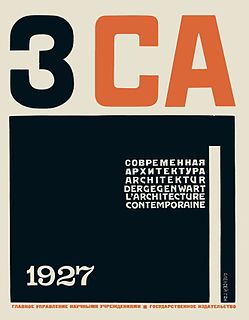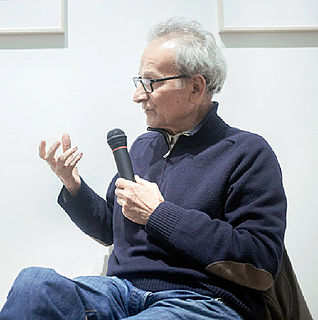Related Research Articles

The avant-garde are people or works that are experimental, radical, or unorthodox with respect to art, culture, or society. It is frequently characterized by aesthetic innovation and initial unacceptability.

The International Style or internationalism is a major architectural style that was developed in the 1920s and 1930s and was closely related to modernism and modern architecture. It was first defined by Museum of Modern Art curators Henry-Russell Hitchcock and Philip Johnson in 1932, based on works of architecture from the 1920s. The terms rationalist architecture and modern movement are often used interchangeably with International Style, although the former is mostly used in the English-speaking world to specifically refer to the Italian rationalism of architects such as Giuseppe Terragni and Gino Pollini, or even the International Style that developed in Europe as a whole.

The Russian avant-garde was a large, influential wave of avant-garde modern art that flourished in the Russian Empire and the Soviet Union, approximately from 1890 to 1930—although some have placed its beginning as early as 1850 and its end as late as 1960. The term covers many separate, but inextricably related, art movements that flourished at the time; including Suprematism, Constructivism, Russian Futurism, Cubo-Futurism, Zaum and Neo-primitivism. Many of the artists who were born, grew up or were active in what is now Belarus and Ukraine, are also classified in the Ukrainian avant-garde.
Starchitect is a portmanteau used to describe architects whose celebrity and critical acclaim have transformed them into idols of the architecture world and may even have given them some degree of fame among the general public. Celebrity status is generally associated with avant-gardist novelty. Developers around the world have proven eager to sign up "top talent" (i.e., starchitects) in hopes of convincing reluctant municipalities to approve large developments, of obtaining financing or of increasing the value of their buildings. A key characteristic is that the starchitecture is almost always "iconic" and highly visible within the site or context. As the status is dependent on current visibility in the media, fading media status implies that architects lose "starchitect" status—hence a list can be drawn up of former "starchitects".

Phaidon Press is a global publisher of books on art, architecture, design, fashion, photography, and popular culture, as well as cookbooks, children's books, and travel books. The company is based in London and New York City, with additional offices in Paris and Berlin. With over 1,500 titles in print, Phaidon books are sold in over 100 countries and are printed in English, French, Spanish, German, Italian, Mandarin, and dozens of other languages. Since the publisher's founding in Vienna in 1923, Phaidon has sold more than 42 million books worldwide.
George Costakis was a collector of Russian avant-garde. In the years surrounding the 1917 revolution, artists in Russia produced the first non-figurative art, which was to become the defining art of the 20th century. Costakis by chance discovered some constructivist paintings in a Moscow studio in 1946, and he went on to search for the revolutionary art which might otherwise have been lost to the world.

Kenneth Brian Frampton is a British architect, critic and historian. He is the Ware Professor of Architecture at the Graduate School of Architecture, Planning, and Preservation at Columbia University, New York. He has been a permanent resident of the United States since the mid-1980s. Frampton is regarded as one of the world's leading historians of modernist architecture.

Alexander Aleksandrovich Vesnin, together with his brothers Leonid and Viktor, was a leading light of Constructivist architecture. He is best known for his meticulous perspectival drawings such as Leningrad Pravda of 1924.

Julius Shulman was an American architectural photographer best known for his photograph "Case Study House #22, Los Angeles, 1960. Pierre Koenig, Architect." The house is also known as the Stahl House. Shulman's photography spread the aesthetic of California's Mid-century modern architecture around the world. Through his many books, exhibits and personal appearances his work ushered in a new appreciation for the movement beginning in the 1990s.

Moisei Yakovlevich Ginzburg was a Soviet constructivist architect, best known for his 1929 Narkomfin Building in Moscow.

Constructivist architecture was a constructivist style of modern architecture that flourished in the Soviet Union in the 1920s and early 1930s. Abstract and austere, the movement aimed to reflect modern industrial society and urban space, while rejecting decorative stylization in favor of the industrial assemblage of materials. Designs combined advanced technology and engineering with an avowedly communist social purpose. Although it was divided into several competing factions, the movement produced many pioneering projects and finished buildings, before falling out of favour around 1932. It has left marked effects on later developments in architecture.

ASNOVA was an Avant-Garde architectural association in the Soviet Union, which was active in the 1920s and early 1930s, commonly called 'the Rationalists'.

The OSA Group was an architectural association in the Soviet Union, which was active from 1925 to 1930 and considered the first group of constructivist architects. It published the journal SA. It published material by Soviet and overseas contributors. However this led to them being attacked as a 'Western' group and some individuals as being 'bourgeois'. After the closure of the group, their modernist approach to architecture and town planning was eliminated in the Soviet Union by 1934, in favour of social realism.
William J. R. Curtis is an architectural historian whose writings have focused on twentieth century architecture. Curtis seems particularly interested in broadening the "canon" to include a wider range of architects working across the world.
Iwao Yamawaki, born Iwao Fujita in Nagasaki, was a Japanese photographer and architect who trained at the Bauhaus.

Jean-Louis Cohen is a French architect and architectural historian specializing in modern architecture and city planning. Since 1994 he has been the Sheldon H. Solow Professor in the History of Architecture at New York University Institute of Fine Arts.

Guido Guidi is an Italian photographer. His work, spanning over more than 40 years, has focused in particular on rural and suburban geographies in Italy and Europe. He photographs places that are normally overlooked. His published works include In Between Cities,Guardando a Est,A New Map of Italy and Veramente.

Boris Vsevolodovich Ignatovich was a Soviet photographer, photojournalist, and cinematographer. He was a pioneer of Soviet avant-garde photography in the 1920s and 1930s, one of the first photojournalists in the USSR, and one of the most significant artists of the Soviet era.

Steel: Armco, Middletown, Ohio is a black and white photograph taken by American photographer Edward Weston in 1922. The picture has the dimensions of 23 by 17,4 cm.
The Kharkiv School of Photography (KSOP) is one of the most notable Ukrainian artistic photography movements. It was created in opposition to the Soviet socialist realism art style, which reigned from 1934 until the 1980s. KSOP started to form in the 1960s when artistic photography revived in Kharkiv during the period of the Khrushchev Thaw. KSOP's official formation as a non-conformist underground movement was denoted by the establishment of a group by Kharkiv photographers named the Vremia Group 1971; its foundation is considered the sign of the revival of modernist art in Kharkiv.
References
- Richard Anderson (2008). "Taking Stock: Documenting Russia's Modern Heritage" (PDF). Future Anterior . 5 (1). ISSN 1549-9715 (print), ISSN 1934-6026 (online). See also other articles from the same issue illustrated by Pare